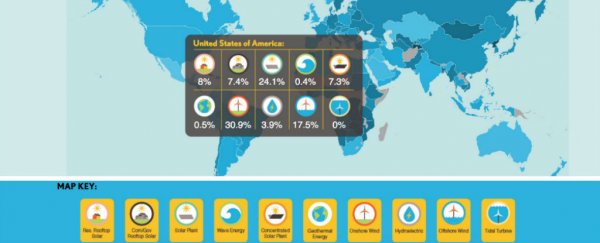The world could be powered almost entirely by clean, renewable energy sources in the space of a few decades, and two engineers in the US say they've have figured out exactly how it can be done.
Blueprints for 139 countries around the world, including the US, Japan, and Australia, break down exactly how many wind turbines, solar farms, hydroelectric dams, and other facilities are required to cover each nation's personal, business, industry, agriculture, and transport power needs, and how much it would cost. They'll be presented to leaders of 195 nations at the 2015 United Nations Climate Change Conference (COP 21) in Paris, starting on November 30, where a binding and universal agreement on climate will be set.
"The people there are just not aware of what's possible," one of the researchers, Mark Jacobson, a civil and environmental engineer at Stanford University, told Mark Fischetti at Scientific American. Jacobson has been granted two opportunities to speak at the conference, which will run from November 30 to December 11, and plans to get on-on-one time with as many world leaders as possible during that time with his colleague, engineer Mark Delucchi from the University of California, Davis.
You can view each country's break-down in this awesome visualisation.
View the full-sized version here.
The purpose of the blueprints is to show that 100 percent renewable energy isn't just a green pipe dream - it's technically and economically feasible. And it won't only save countries a significant amount of cash - Jacobson and Delucchi have figured out how many jobs it could create and lives it could save, and it's a whole lot.
As Fischetti reports for Scientific American, if all 139 countries followed their plans for permanently ditching fossil fuels, it would open up 24 million construction jobs and 26.5 million operational jobs, each with a 35-year lifespan, which more than covers the 28.4 million jobs that would be lost in collapsed fossil fuel industries.
The change would also lead to considerably cleaner air, which the engineers have estimated will prevent the 3.3 to 4.6 million premature deaths that occur every year due to atmospheric pollution. Right now, these deaths cost around 3 percent of the global GDP to mitigate.
And that's not the only saving that a fossil fuel-free world can bring. Wind is now the cheapest source of electricity in the US, costing around half as much as natural gas - and that's unsubsidised. And the cost of solar is not far behind.
As Ramez Naam reports over at Energy Post, if the technology continues to grow in efficiency at the current rate, by the time solar capacity triples to 600GW - predicted by around 2020 or 2021 - the unsubsidised price for solar power will be roughly 4.5 cents per kWh in places that get a lot of sunlight, such as the the US southwest, the Middle East, and Australia. For moderately sunny places, such as India and China, this price will hit 6.5 cent per kWh.
Not bad, when you consider coal-fired electricity can cost anywhere from 6.6 to 15.1 cents per kWh and it's 6 to 8 cents for natural gas. And that's not including all the associated health costs mentioned above.
"People who are trying to prevent this change would argue that it's too expensive, or there's just not enough power, or they try to say that it's unreliable, that it will take too much land area or resources," Jacobson told Adele Peters at Fast Company. "What this shows is that all these claims are mythical."
The timeline states that countries could stop building new natural gas, coal, and nuclear plants, by 2020 and all gas-fired home appliances would be shifted to electric. Over the next five years, governments and industry leaders could work on getting large ships, trains, and buses off fossil fuels to run on electric power instead, followed by all cars and trucks over the next five years. By 2050, everything that currently guzzles fossil fuels could feasibly be switched over to renewable power sources.
Of course, not everyone is convinced, says Fischetti, reporting that the plans "have been heralded as transformational, and criticised as starry eyed or even nutty", but the beauty of what Jacobson and Delucchi have put together is that everything is there for you to read through and analyse yourself, so you can make up your own mind.
